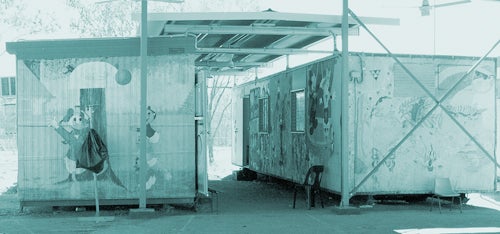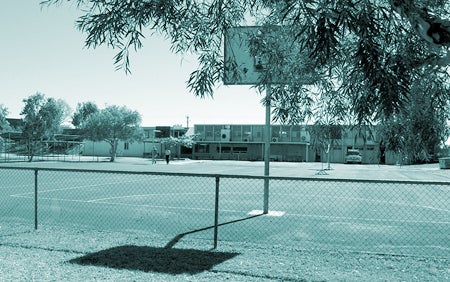A last resort? - Summary Guide: Education

A last resort?
National Inquiry into Children in Immigration Detention

In Port Hedland there is a school
outside ... I used to stand on a chair and look out at them. I like
to see what they looked like in their school uniform. There was
an officer … and she pulled my shoulder down and put me on
the ground and said, ‘You are not allowed to look at those
people because they are different to you.’ And I was like
‘Why are they different to me? Because they know English and
they are Australian, does that make them better?’
Teenage boy, Perth focus group
All children in Australia have a right to education.
Under the Convention on the Rights of the Child, Australian governments
are required to provide, as a minimum, primary education that is 'compulsory
and available free to all' and secondary education that is 'available
and accessible to every child'.
All children in Australia, regardless of their nationality,
their immigration status, or how they arrived in the country, have the
same right to education.
The Inquiry looked at whether children in immigration detention
received a standard of education that was comparable to 'similar children'
in the Australian community. To help make this assessment, the Inquiry
looked at the education services available to refugee children and asylum-seeker
children living in the community.
It is the responsibility of the Department to ensure that
detainee children receive an adequate education.
Since 1999, most detainee children have had access to educational
programs inside detention centres. For several years, some detainee children
from some centres have attended local schools outside their detention
centre.
Since late 2002 this opportunity was extended to most detainee
children. However, as most children in immigration detention over the
period of the Inquiry attended internal detention centre schools, it was
important to examine the quality of that education.
How does the detention environment affect children's ability
to learn?
When I first came here, we were
very hopeful to get out – we thought our stay here was very
short … after that I became very upset and depressed and because
of my mental condition I couldn’t bring myself to go to the
school.
Teenage boy, Curtin
Children in detention often carry with them experiences
that make learning very difficult, such as the effects of past torture
and trauma. However, the detention environment itself makes learning even
harder.
Experts told the Inquiry that factors such as riots and disturbances,
moving from one compound to another, disruptions associated with arrivals
and releases and uncertainty over visa applications, all undermine the
effectiveness of education programs.
Of most particular concern, however, was the mental health
of children, which deteriorated the longer they were in detention. Detainee
children told the Inquiry that depression and anxiety made it very difficult
for them to concentrate and learn.
In addition, children's attendance at on-site schools
declined with the length of time they had spent in detention and as they
grew older because they felt depressed and because the classes didn't
meet their needs.

School education buildings and recreation area
at Curtin, June 2002
Education in detention centres
The lack of adequate education
programs is a major issue.
More often than not no trained teacher [is] available, classes are
irregular at best, no curriculum, no subject programs or timetables
and no learning outcomes identified. This also has a negative impact
on the behaviour of the children as they don’t have enough
to occupy their time constructively.
Department Manager Report, Port
Hedland,
January - March 2001
Despite the significant efforts of teachers, the Inquiry
found that there were fundamental problems associated with providing education
services in on-site schools throughout the period of the Inquiry. These
included:
- insufficient infrastructure
- inadequate hours of tuition
- inadequate educational assessments and reporting of children's
progress.
Two other significant problems - the lack of an appropriate
curriculum and the shortage of teachers - are discussed below.
Many of these problems were substantially addressed
when, in 2002, the Department arranged for increasing numbers of children
to attend local schools.
Curriculum and resources
There was no curriculum set
or advised by ACM or [the Department] ...
we were certainly given some classrooms to teach [in at Woomera]
and some materials in terms of white boards … but nothing
in terms of what type of syllabus for any subject so we made that
up ourselves.
Former Woomera teacher, submission
to the Inquiry
An effective education requires a carefully developed
curriculum which is appropriate to the needs of children. It also requires
adequate resources. Former education staff and community organisations
presented evidence to the Inquiry that the curriculum offered to detainee
children at on-site schools varied considerably over time and between
centres - however, it was often inadequate and unstructured.
Detainee children and parents consistently said that
a lack of age-appropriate teaching resources restricted children from
receiving an education suitable for their age and needs. This was a particular
concern for older children.
There was only one class and
everybody like from five year old and I were put in the same class.
And what they did was put a photocopy of some basic mathematics
in front of us and they were trying … to teach me simple addition
and these sort of things – basic mathematics.
Teenage girl, Curtin
Further, there were limited learning opportunities
for detainee children aged 15 and over – even though two years of
post-compulsory schooling are available to children across Australia.
At this age detainee children were encouraged to enrol in education programs
for adult detainees, which were generally inappropriate to these children’s
needs.
We had no computers. We had pens
and exercise books. We just copied from difficult books, some books
like dictionaries, just copying, then put in the rubbish bin. No
easy story books, just dictionaries. Not learning English, just
copying and copying.
We were like a printer!
Teenage girl, quoted in NSW Commission
for Children & Young People,
submission to the Inquiry
By late 2002, efforts were made to expand the curriculum
in some centres, particularly in Woomera and Baxter. However, this expanded
program was not given sufficient resources in the early stages.
Availability of teachers
Evidence to the Inquiry highlighted the significant shortage
of suitably qualified teachers in detention centres, particularly in Woomera
and Port Hedland, which at times had very large numbers of children.
For instance, there were 282 children at Woomera on 1 August
2001 and 456 children there on 1 September 2002. However, during these
months no more than five teachers were employed - often the number was
less. By contrast, there is one teacher for every 25 to 30 students in
Australian primary schools.
To cope, adult detainees without Australian teaching qualifications
were sometimes called upon to teach classes. Mostly they acted as teaching
assistants but occasionally they taught classes alone.
This shortage of teachers also had an effect on the hours
of tuition students received. In most Australian schools, students receive
approximately six hours of teaching each day. However, detainee children
attending on-site schools prior to the end of 2001 received considerably
fewer hours of tuition. For example, ACM documents show that during 2001
teaching hours at Woomera varied between one and three each day, depending
on detainee numbers.
The high turnover of teachers also undermined the quality
and availability of education programs.
Finally, in some centres during 2002, teachers wore ACM uniforms
and security earpieces and consequently it was initially difficult for
children to distinguish teachers from detention officers.
Attending local community schools
Prior to 2002, education for detainee children largely took
place in on-site schools in detention centres. Some child detainees from
some detention centres were able to attend local schools in the community.
However the arrangements for this provision of external education were
ad hoc and the opportunity was only extended to a small number of children
in detention.
From mid-2002, increasing numbers of children in detention
were allowed to attend local schools, after the Department began to negotiate
agreements with State and Territory education authorities. By the end
of 2003, the majority of children in detention were attending external
schools.
Evidence to the Inquiry was clear about the benefits - child
detainees are able to experience a 'normal day' outside the detention
centre, be taught a full curriculum, socialise with other children and
make new friends, all of which improves their well-being. The Department
Manager in Port Hedland reported in June 2002 that the '[b]ehaviour and
socialisation skills of the children [are] improving as a result of attending
community schools.'
Parents told the Inquiry that they preferred their
children to attend external school. However, these benefits can be offset
by the experience of returning to the detention centre each afternoon.
When we go outside we see the
children, they go out free, when they go back home, we have to come
back here. Sometimes they say to each other, ‘We’re
going to beach or somewhere else’ - we can’t go.
Teenage boy, Port Hedland
Not all children, however, were allowed to attend external
schooling. For example, at Curtin, ACM staff determined whether a child
could attend the local school, based on how well they thought the child
would cope, their level of English and their social skills. Children in
the Australian community are never excluded from school on the basis of
requirements such as these.
In addition, some older children aged 16 and above were denied
the opportunity to attend external schooling because of their age. Being
denied access to attend a local school had a detrimental effect on some
children, contributing to greater levels of depression which, in turn,
affected their ability to learn in the detention centre school.

St Cecilia’s Catholic school attended by
children in Port Hedland,
June 2002
When did children in detention attend local schools?
Maribyrnong
|
1998
|
Children had access to education
at St Margaret Mary's Catholic primary school from the beginning of 1998. Approximately 12 children participated in this arrangement. 2002 In October children began attending the local State schools. |
Port Hedland
|
1998
|
Two children enrolled at St Cecilia's
Catholic primary school. 2002 In April two children began attending St Cecilia's. From May, all children attended the school. |
Curtin
|
2001
|
Children commenced at Derby District
High School in March 2001 - five children attended during 2001. 2002 Approximately 16 children attended Derby District High School - a small proportion of the children detained at the time. |
Villawood
|
2002
|
In August 2002 some children began
attending local State schools. More children commenced at external schools in October, however, not all children could participate. |
Woomera
|
2002
|
In December, primary school-aged
children commenced attending St Barbara's Catholic Parish School in Roxby Downs, two days a week. 2003 By mid-2003 children detained at the Woomera Residential Housing Project were attending the Woomera Area School. |
Baxter
|
2003
|
In March 2003 secondary school-aged
children began attending local State schools, with primary school-aged children attending local State schools from April 2003. Some children were excluded from these arrangements. |
Inquiry finding
The Commonwealth failed to take
all appropriate measures to provide children in immigration detention
with an adequate education over the period of the Inquiry, resulting
in a breach of the Convention on the Rights of the Child. Many problems
were addressed when child began attending external schools.
